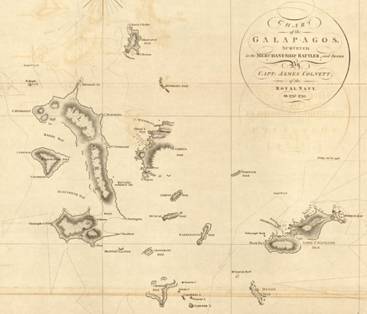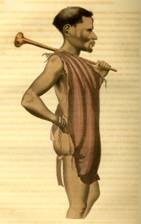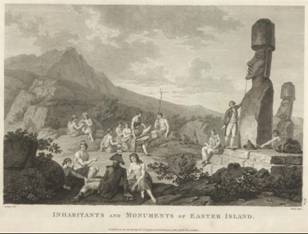Charles Darwin's Beagle library
"books; those most valuable of all valuable things"
Darwin to Catherine Darwin 1833
| Audio version of this introduction - YouTube |
The voyage of the Beagle (1831-1836) was one of the most important scientific expeditions in history. On board was the young naturalist Charles Darwin. His investigations would eventually change science and the world forever. There was no sudden discovery on the Galapagos sparked by the finches as popular legend has it. Instead he sought to comprehensively study and record the geology, animals, plants and peoples of the lands visited. Along the way he made a number of striking discoveries, particularly in South America, which eventually led him to realize that living things must change or evolve over time. After his return home he formulated what he called "natural selection" to explain how living things adapt to a changing world. When he published his revolutionary On the Origin of Species in 1859, he began with the famous opening line "When on board H.M.S. 'Beagle,' as naturalist, I was much struck with certain facts..." (p. 1)
As a research vessel HMS Beagle may not have had the internet, but she did have an impressive state-of-the-art library of about 400 volumes. The library was housed in book cases in the poop cabin at the stern of the ship, which was also Darwin's cabin. Thus, Darwin lived and worked in the Beagle library for nearly five years.
 | ||
Aft part of HMS Beagle, by P.G. King for Murray's 1890 illustrated edition. One of the bookcases is here in red. The original sketches are reproduced in Keynes's Beagle diary. | A scale diagram of the poop cabin, probably drawn by one of the officers, with Darwin's annotations, including on the right and bottom, "Book Cases". (CUL-DAR44.16)
|
The library consisted of works that belonged to Captain FitzRoy, the officers and Darwin. There was originally a catalogue which is not known to survive. So the contents of the library were long a mystery.
Reconstructing the lost library
![]() In the 1980s, the editors of the Correspondence of Charles Darwin reconstructed a list of 132 works that were probably in the library based on evidence from Darwin's notes and other sources. (That list and a very important introduction, including a copy of the library regulations, is online here [new link after the page was moved to a different address on their site]) Further works in the library were later identified from Darwin's surviving books and published in Marginalia (1990) and later still and during the editing of his field notebooks and for this project, such as Phillip 1789 mentioned in FitzRoy's Narrative 2: 621.
In the 1980s, the editors of the Correspondence of Charles Darwin reconstructed a list of 132 works that were probably in the library based on evidence from Darwin's notes and other sources. (That list and a very important introduction, including a copy of the library regulations, is online here [new link after the page was moved to a different address on their site]) Further works in the library were later identified from Darwin's surviving books and published in Marginalia (1990) and later still and during the editing of his field notebooks and for this project, such as Phillip 1789 mentioned in FitzRoy's Narrative 2: 621.
Some of the references in Darwin's notes are very brief and obscure. For example, while on the Pacific island of Tahiti, Darwin noted cryptically in his Galapagos notebook (p. 55b), "Ellis horse story." What could this mean? The Beagle Library provides the answer.
This was a shorthand reference to a book by the missionary William Ellis who described the first horse being landed at Tahiti in 1817. The horse fell overboard and the natives on the ship "plunged into the water, and followed like a shoal of sharks or porpoises." (Ellis 1829, vol. 1, p. 148.) Darwin too thought the Tahitians seemed at home in the water. When he came to write his Journal of researches, he mentioned "The Tahitians have the dexterity of amphibious animals in the water." (Journal of researches, p. 486) Some works referred to in Darwin's Beagle notes etc. cannot be said with certainty to have been in the library. While noting these tentative items as such in our catalogue, we have included them in the online Beagle library.
Combining the existing lists from the Correspondence and Marginalia with our new research creates this catalogue of 199 works, totalling c.429 volumes. This is remarkably close to FitzRoy's estimate in a 16 March 1826 letter to his sister "I flatter myself I have a complete library in miniature, upwards of 400 volumes!"
In addition, there were newspapers (both from home and from the places visited by the Beagle) and other ephemeral printed matter on the Beagle which we may never be able to reconstruct.
The Beagle library was dispersed when the voyage ended in October 1836. It has now been electronically re-constructed as part of The Complete Work of Charles Darwin Online. The (2012-14) Beagle library project was funded by an Academic Research Fund granted by the Ministry of Education of the Singapore Government and supported by the Office of the Dean of the Faculty of Science and Charles Darwin University and the Charles Darwin University Foundation, Northern Territory, Australia. The project is directed by John van Wyhe who first proposed reconstructing the Beagle library in 2006 while editing the Beagle field notebooks.
To achieve this reconstruction, scans of the books have, in most cases, been sourced online and then specially transcribed to make them searchable under the powerful Darwin Online search engine. We have been careful to use the same editions that Darwin had, or when not obtainable, the closest available. We have added missing pages, maps and illustrations when those on Google Books or the Internet Archive, for example, were missing. And we have added better illustrations when we could find them. Other works in the library have been digitized here for the first time, for example the plates for Humboldt's Personal narrative are available nowhere else online in colour.
Now, for the first time, it is possible to search through the Beagle library in an instant for quotations, places, people, species and so forth. To search: CLICK HERE
See the library catalogue HERE
For Darwin's later personal library, click here.
Darwin Online provides by far the world's largest collection of Beagle voyage materials, CLICK HERE
Some totals
The online Beagle library consists of over 200,000 pages containing more than 5,000 illustrations. The library can be roughly broken into the following categories: 
Travel/voyages 36%
Natural History 33%
Geology 15%
Atlases/Nautical 7%
Literature 4%
Reference 3%
History 2%
At least 31% of the library was in foreign languages. There were 125 English titles, 38 French, 9 Spanish, 7 German, 1 Latin and 1 Greek.
Illustrations
Another surprise revealed by the online Beagle library is the enormous and rich visual gallery it contained. Many of the works were beautifully illustrated with woodcuts, engravings or lithographs of animals or scenes of exotic lands. The online Beagle library now allows anyone to see the amazing range of visual imagery that Darwin poured over during the voyage.
See the illustrations here
 |
Humboldt's illustration of his famous ascent of Mount Chimborazo in the Andes in 1802. |
Reading on the Beagle
As the Beagle was preparing to depart from England on her voyage around the world, Darwin outlined what he saw as his work list:
The principal objects are 1st, collecting observing & reading in all branches of Natural history that I possibly can manage. Observations in Meteorology. — French & Spanish, Mathematics, & a little Classics, perhaps not more than Greek Testament on Sundays. I hope generally to have some one English book in hand for my amusement, exclusive of the above mentioned branches. (Beagle diary, p. 13.)
Clearly the library formed a major part of Darwin's Beagle voyage research from the start. Having the library now available online reveals the sources and inspirations that Darwin read day after day as he swung in his hammock during long sea crossings or as he worked on his specimens at the chart table or under his microscope. The Beagle library was always at his finger tips. Before the Beagle reached a new location, Darwin was able to read the reports of earlier visitors. He could thus begin his work well armed with whatever was already known rather than starting from scratch. The scientific questions he found answered and indeed left unanswered in the library coloured the way he thought about what he encountered.
Perhaps the most important work for Darwin was Charles Lyell's Principles of Geology. This profoundly influenced Darwin not only as a geologist and scientific theorist but contained the latest discussion of "the gradual birth and death of species." (vol. 3, p. 33) (See in important introduction to Lyell's book by Gordon Chancellor here.) Darwin's most inspiring model for a scientific traveller, and one of his favourite books, was Alexander von Humboldt's Personal narrative. Of this, there were in fact two copies on board. (See an introduction by Gordon Chancellor here.)
Darwin saw himself following in the footsteps of earlier voyage naturalists, as indeed he was. In May 1832 he recorded: "I have just finished Ansons voyage, my pleasure in reading such works is at least trebled by expecting to see some of the described places & in knowing a little about the sea." (Beagle diary, p. 66.) During one sluggish and "tedious" trip in July 1832 when the Beagle made slow time because of poor winds, Darwin noted "The only thing I have been able to do is reading Voyages & Travels.— these are now to me much more interesting than even novels." (Beagle diary, p. 83.)
The Beagle library was well-stocked with a magnificent collection of classic voyages such as Narborough's An account of several late voyages (1694), Wafer's A new voyage and description of the isthmus of America (1699), Dampier's A new voyage round the world (1697), Pernety's Journal historique d'un voyage (1769), Bougainville's A voyage round the world (1772), Hawkesworth's Voyages in the Southern Hemisphere (1773), Cook's A voyage to the Pacific Ocean (1784), La Pérouse's A voyage round the world (1798-9) and Vancouver's A voyage of discovery (1798).
As Darwin spent much of the voyage investigating the coasts and interior of South America, he studied the works of earlier travellers there with great care including Ulloa's A voyage to South America (1806), Caldcleugh's Travels in South America (1825), Molina's Compendio (1788), Spix and Martius' Travels in Brazil (1824) and Darwin's own copy of Miers' Travels in Chile and La Plata (1826).
'Present state of the Temple of Serapis at Puzzuoli.' Frontispiece to volume 1 of Lyell's Principles of Geology (1830). |
When the Beagle reached the Galapagos islands in September 1835, Darwin first noted the extraordinary marine iguanas in his Galapagos notebook with the scientific name "Amblyrhyncus", a name he found in Byron's Voyage of H.M.S. Blonde (1826). Byron had described the iguanas as "the ugliest living creatures we ever beheld." Darwin consulted other works in the Beagle library that provided information on the curious creatures of the Galapagos. Captain James Colnett visited the islands in 1792. Darwin scribbled in his Zoology notes that Colnett 1798 claimed that the marine iguanas "go out to sea in shoals to fish" But Darwin doubted this: "I cannot believe this is the object, nor is it very clear what their object can be." Darwin dissected several specimens to find out and discovered nothing but seaweed in their stomachs. Clearly they were not fishing.

The Galapagos marine iguana from Darwin 1845.
Darwin used Werner's Colours (1821) to record the colours that could not be preserved such as fish or the eyes of birds. The book contained little squares of paper painted in different colours- which were standard in any example of the published book. For example, Darwin recorded a snake in his St. Fe notebook in 1835 as "primrose yellow", a colour given on pages 38 and 64. Leonard Jenyns, who published descriptions of Darwin's fish specimens, reported: "[Darwin] informs me, that a comparison was always made with the book in hand, previous to the exact colour in any case being noted" (Fish, p. x)
A page from Werner's Colours (1821)
Darwin's reading was not exclusively scientific. As he recalled in his Autobiography "Milton's Paradise Lost had been my chief favourite, and in my excursions during the voyage of the Beagle, when I could take only a single small volume, I always chose Milton." Darwin also read Samuel Richardson's novel about the virtuous fictional hero Sir Charles Grandison (1781). On 4 September 1833, while Darwin waited to start his next inland trek, he noted having read a Spanish edition of the politically charged trial of Queen Caroline, consort of George IV as well as "Shenstones Prose & Spanish story book: nobody knows pleasure of reading till a few days of such indolence." (B. Blanca notebook, p. 12a) Darwin also had two copies of the New Testament, one to keep up his Greek and the other to help with his nascent German.
How you can help. In order to complete the work on the Beagle Library we still need $20,000 of further funding to have the library completely transcribed. If you can help please contact Dr John van Wyhe dbsjmvw@nus.edu.sg. Donations are tax deductible.
Acknowledgements
The Darwin Online project, formerly at the University of Cambridge, is now based at the Department of Biological Sciences at the National University of Singapore. We thank especially Paul Matsudaira, Lisa Lau, Soong Beng Ching and Nursyidah Mansor. Thanks also to Shanthavalli d/o Kumarasamy of the Dean's Office, Faculty of Science.
The funding for the online Beagle library was generously provided by an Academic Research Fund grant from the Ministry of Education of the Singapore Government, the Office of the Dean of the Faculty of Science, National University of Singapore, as well as Charles Darwin University (CDU) and the Charles Darwin University Foundation, Northern Territory, Australia. Special thanks to Professor Barney Glover (previous Vice-Chancellor) and Maryanne McKaige at CDU. See Beagle Connections.
The Beagle library reconstruction is based largely on the important research published by the Darwin Correspondence in 1985. Kees Rookmaaker carried out much of the work of identifying and locating the editions needed and much other important research. Antranig Basman undertook a major server upgrade to allow Darwin Online to continue functioning with a near doubling of its content. Angus Carroll generously provided scans of rare and important works. Additional assistance was kindly provided by Dan Lewis and The Huntington Library, San Marino, California, Adam Perkins and Cambridge University Library, Gordon Chancellor and Simon Keynes. AEL Data worked very hard to meet our special requirements and to help us achieve the maximum amount of searchable text on our budget.
This project could not have been achieved without the many large digitisation projects which we have used including Google Books, the Biodiversity Heritage Library, the Internet Archive and Project Gutenberg. Many of the maps and images are copied from the excellent David Rumsey Map Collection. Important online catalogues, in particular Copac and the Karlsruhe Virtual Catalog were also of great importance. The title image to this introduction consists of spines of works that were on the Beagle, not the actual copies. The painting in the centre, 'HMS Beagle in the Galapagos, 17 October 1835 2.15 p.m.', is a cropped version of the famous work of John Chancellor and is reproduced courtesy of Gordon Chancellor.
























